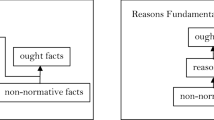Abstract
Recent studies by experimental philosophers demonstrate puzzling asymmetries in people’s judgments about intentional action, leading many philosophers to propose that normative factors are inappropriately influencing intentionality judgments. In this paper, I present and defend the Deep Self Model of judgments about intentional action that provides a quite different explanation for these judgment asymmetries. The Deep Self Model is based on the idea that people make an intuitive distinction between two parts of an agent’s psychology, an Acting Self that contains the desires, means-end beliefs, and intentions that are the immediate causal source of an agent’s actions, and a Deep Self, which contains an agent’s stable and central psychological attitudes, including the agent’s values, principles, life goals, and other more fundamental attitudes. The Deep Self Model proposes that when people are asked to make judgments about whether an agent brought about an outcome intentionally, in addition to standard criteria proposed in traditional models, people also assess an additional ‘Concordance Criterion’: Does the outcome concord with the psychological attitudes of the agent’s Deep Self? I show that the Deep Self Model can explain a very complex pattern of judgment asymmetries documented in the experimental philosophy literature, and does so in a way that has significant advantages over competing models.



Similar content being viewed by others
Notes
Knobe himself does argue for the existence of backtracking influences from normative judgments to intentionality judgments as postulated in the Bidirectional Model. But he doesn’t view these backtracking influences as inappropriate. This intriguing point is defended in various papers, especially Knobe (2006). But since many theorists (myself included) find the backtracking influences postulated in the Bidirectional Thesis to be improper and epistemically unjustifiable, I continue to call these backtracking influences ‘inappropriate’ throughout the paper.
An alternative approach to explaining the pattern of asymmetry findings in the literature is to argue that no single unified model can capture subjects’ varied and inconsistent intuitions. See Doris et al. (2007), and the highly provocative arguments therein, for this kind of approach.
The only previous use of the term ‘Deep Self’ that I located in the philosophical literature is from Arpaly and Schroeder (1999). My notion of an agent’s Deep Self appears to be broadly similar to theirs, though I am not at all sure whether my notion is identical to theirs.
In statistical testing, subjects’ ratings were compared with ‘4’, the middle point on the scale, since the extent to which ratings fall below ‘4’ represents the degree to which the Chairman is rated as being anti-environment. By this measure, the Chairman was found to significantly anti-environment in both conditions (Harm Condition: T(19) = 11.02, p < 0.001, Help Condition: T(19) = 6.30, p < 0.001). Subjects’ rating were also compared between the two conditions, which showed that the Chairman is judged as being more anti-environment in the Harm Condition than in the Help Condition (T(38) = 2.85, p = 0.007).
I thank an anonymous reviewer at Philosophical Studies for helping me see and formulate this objection.
Knobe actually argues that the moral badness of the outcome is not needed. Any kind of badness, moral or not, is sufficient to generate the backtracking influence from the normative judgment that the outcome is bad to the intentionality judgment. I ignore this complication as it is not relevant to my overall argument.
For the Pizarro et al. study, ratings were as follows: Case a 1.4, b 6.1, c 1.6, d 7.9, and there was a significant outcome valence by decision process (i.e. emotion versus deliberation) interaction driven by the fact that case b differed from case d (p < 0.05).
Since ‘deliberately’ can be regarded as being inappropriately close in meaning to ‘intentionally’, vignettes c and d were modified slightly to read: c. After calm deliberation, Jack gave the homeless… and d. After calm deliberation, Jack smashed the window….
For my study, ratings were as follows: Case a 1.7, b 3.2, c 1.65, d 1.45. Like Pizarro and colleagues, my study also found a significant valence by decision process (i.e. emotion versus deliberation) interaction driven by the fact that case b differed from the others (F(1,76) = 7.79, p = 0.007).
Pizarro and colleagues did in fact ask subjects the degree to which the agent in each vignette possessed second-order desires that are consistent with impulses to perform the behaviors specified in the vignette. They found no differences across vignettes in judgments that the agent possessed second-order desires consistent with the relevant behaviors, except for the vignette in which Jack smashed the car window due to strong emotion. In this vignette, subjects’ judgments of consistency with second-order desires is significantly reduced, suggesting that Jack is fact imputed by subjects with higher-order desires that repudiate his smashing the window.
References
Arpaly, N., & Schroeder, T. (1999). Praise, blame and the whole self. Philosophical Studies, 93, 161–188.
Doris, J. M., Knobe, J., & Woolfolk, R. L. (2007). Variantism about responsibility. Philosophical Perspectives, 21, 183–214.
Knobe, J. (2003). Intentional action and side effects in ordinary language. Analysis, 63, 190–193.
Knobe, J. (2006). The concept of intentional action: A case study in the uses of folk psychology. Philosophical Studies, 130, 203–231.
Malle, B., & Knobe, J. (1997). The Folk concept of intentional action. Journal of Experimental Social Psychology, 33, 101–121.
Pizarro, D., Uhlmann, E., & Salovey, P. (2003). Asymmetry in judgments of moral blame and praise: The role of perceived metadesires. Psychological Science, 14, 267–272.
Wolf, S. (1990). Freedom within reason. New York: Oxford University Press.
Acknowledgements
Thanks to Joshua Knobe, Thomas Nadelhoffer, Nina Strohminger, Erica Roedder, Sven Nyholm, Angela Mendelovici, and audiences at the Moral Psychology Research Group and Princeton Moral Psychology Conference for invaluable feedback.
Author information
Authors and Affiliations
Corresponding author
Rights and permissions
About this article
Cite this article
Sripada, C.S. The Deep Self Model and asymmetries in folk judgments about intentional action. Philos Stud 151, 159–176 (2010). https://doi.org/10.1007/s11098-009-9423-5
Received:
Accepted:
Published:
Issue Date:
DOI: https://doi.org/10.1007/s11098-009-9423-5



